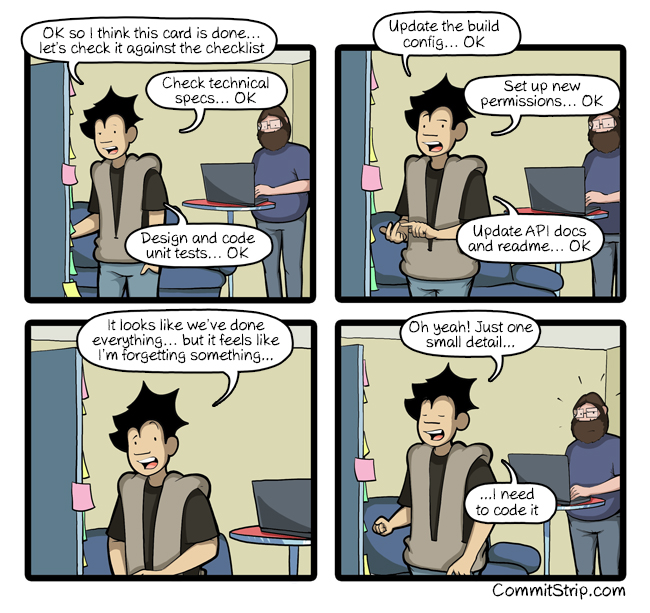In software just about all project management methodologies get labeled one of two things: Agile or Waterfall. There are formal definitions of both labels, but in practice few companies stick to those definitions particularly in the world of consulting. For people who really care about such things, there are actually many more methodologies out there but largely for marketing reasons we call any process that’s linear in nature Waterfall, and any that is iterative we call Agile.

Among consultants I have rarely seen a company that is truly 100% agile or 100% waterfall. In fact I’ve rarely seen a shop that’s close enough to the formal structures of those methodologies to really accurately claim to be one or the other. Nearly all consultancies are some kind of blent of a linear process with stages (sometimes called “a waterfall phase” or “a planning phase”) followed by an iterative process with lots of non-developer input into partially completed features (often called an “agile phase” or “build phase”). Depending on the agency they might cut up the planning into the start of each sprint or they might move it all to the beginning as a separate project phase. Done well it can allow you to merge the highly complex needs of an organization with the predefined structures of an existing platform. Done poorly it can it look like you tried to force a square peg into a round hole. You can see evidence of this around the internet in the articles trying to help you pick a methodology and in the variations on Agile that have been attempted to try to adapt the process to the reality many consultants face.
In 2001 the Agile Manifesto changed how we talk about project management. It challenged standing doctrine about how software development should be done and moved away from trying to mirror manufacturing processes. As the methodology around agile evolved, and proved itself impressively effective for certain projects, it drew adherents and advocates who preach Agile and Scrum structures as rigid rules to be followed. Meanwhile older project methodologies were largely relabeled “ Waterfall” and dragged through the mud as out of date and likely to lead to project failure.
But after all this time Agile hasn’t actually won as the only truly useful process because it doesn’t actually work for all projects and all project teams. Particularly among consulting agencies that work on complex platforms like Drupal and Salesforce, you find that regardless of the label the company uses they probably have a mix linear planning with iterative development – or they fail a lot.
Agile works best when you start from scratch and you have a talented team trying to solve a unique problem. Anytime you are building on a mature software platform you are at least a few hundred thousand hours into development before you have your first meeting. These platforms have large feature sets that deliver lots of the functionality needed for most projects just through careful planning and basic configuration – that’s the whole point of using them. So on any enterprise scale data system you have to do a great deal of planning before you start creating the finished product.
If you don’t plan ahead enough to have a generalized, but complete, picture of what you’re building you will discover very large gaps after far too many pieces have been built to elegantly close them, or your solution will have been built far more generically than needed – introducing significant complexity for very little gain. I’ve seen people re-implement features of Drupal within other features of Drupal just to deal with changing requirements or because a major feature was skipped in planning. So those early planning stages are important, but they also need to leave space for new insights into how best to meet the client’s need and discovery of true errors after the planning stage is complete.
Once you have a good plan the team can start to build. But you cannot simply hand a developer the design and say “do this” because your “this” is only as perfect as you are and your plan does not cover all the details. The developer will see things missed during planning, or have questions that everyone else knows but you didn’t think to write down (and if you wrote down every answer to every possible question, you wrote a document no one bothered to actually read). The team needs to implement part of the solution, check with the client to make sure it’s right, adjust to mistakes, and repeat – a very agile-like process that makes waterfall purists uncomfortable because it means the plan they are working from will change.
In all this you also have a client to keep happy and help make successful – that’s why they hired someone in the first place. Giving them a plan that shows you know what they want they are reassured early in the project that you share their vision for a final solution. Being able to see that plan come together while giving chances to refine the details allows you to deliver the best product you are able.
Agile was supposed to fix all our problems, but didn’t. The methodologies used before were supposed to prevent all the problems that agile was trying to fix, but didn’t. But using waterfall-like planning at the start of your project with agile-ish implementation you can combine the best of both approaches giving you the best chances for success. We all do it, it is about time we all admit it is what we do.
